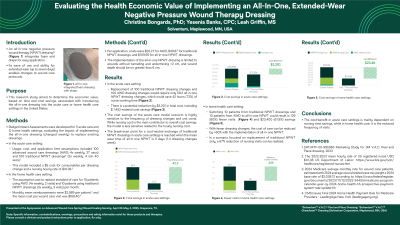Health Economics
(HE-002) Evaluating the Health Economic Value of Implementing an All-in-one, Extended-wear Negative Pressure Wound Therapy (NPWT) Dressing
Friday, May 2, 2025
7:45 PM - 8:45 PM East Coast USA Time

Yesenia Banks, CPC – Sr. Manager, Reimbursement and Health Policy, Medical Affairs, Solventum; Leah Griffin, MS – Director HEOR, Medical Affairs, Solventum
Introduction: An all-in-one negative pressure wound therapy (NPWT) dressing* integrates foam and drape for easy application and is designed for extended wear of up to seven days. This research study aimed to determine the economic value, based on time and cost savings, associated with introducing the all-in-one dressing into the acute care or home health care settings in the US.
Methods: Budget Impact Assessments were developed for 1) acute care and 2) home health settings, evaluating the impact of implementing the all-in-one dressing (1x/week applied, @$106.95) to replace existing dressings. In the acute care setting, usage, cost, and application time assumptions included 100 advanced wound care dressings (AWD; changed 4x/week, @$20, 27 sec) and 100 traditional NPWT dressings† (changed 3x/week, @$49.87, 4 min 40 sec). This model included a $5 cost for consumables per dressing change and a nursing hourly rate of $41.38. For home health, the assumption was care for 10 patients using AWD (2 visits/week @$20) and 10 patients using traditional NPWT dressings (3 visits/week) per month, with a monthly mean reimbursement of $2989 per patient and a mean cost per wound care visit of $168.40.
Results: Implementing the all-in-one dressing in acute care settings could save 42 (72%) hours of nursing time and $3,201 (30.8%) in dressing change costs, including material and nursing time. In home health care, switching 10 patients from traditional NPWT dressings to AWD could result in 129 (61.8%) fewer visits and $23,400 (60%) savings. The frequency of dressing changes is key to obtaining cost benefits. The break-even point for a cost-neutral exchange of traditional NPWT dressings in acute care settings is reached when the mean wear time is 5 days.
Discussion: The cost-benefit in acute care settings is mainly dependent on nursing time savings, while in home health care, it is the reduced frequency of visits.
Methods: Budget Impact Assessments were developed for 1) acute care and 2) home health settings, evaluating the impact of implementing the all-in-one dressing (1x/week applied, @$106.95) to replace existing dressings. In the acute care setting, usage, cost, and application time assumptions included 100 advanced wound care dressings (AWD; changed 4x/week, @$20, 27 sec) and 100 traditional NPWT dressings† (changed 3x/week, @$49.87, 4 min 40 sec). This model included a $5 cost for consumables per dressing change and a nursing hourly rate of $41.38. For home health, the assumption was care for 10 patients using AWD (2 visits/week @$20) and 10 patients using traditional NPWT dressings (3 visits/week) per month, with a monthly mean reimbursement of $2989 per patient and a mean cost per wound care visit of $168.40.
Results: Implementing the all-in-one dressing in acute care settings could save 42 (72%) hours of nursing time and $3,201 (30.8%) in dressing change costs, including material and nursing time. In home health care, switching 10 patients from traditional NPWT dressings to AWD could result in 129 (61.8%) fewer visits and $23,400 (60%) savings. The frequency of dressing changes is key to obtaining cost benefits. The break-even point for a cost-neutral exchange of traditional NPWT dressings in acute care settings is reached when the mean wear time is 5 days.
Discussion: The cost-benefit in acute care settings is mainly dependent on nursing time savings, while in home health care, it is the reduced frequency of visits.

.jpg)
